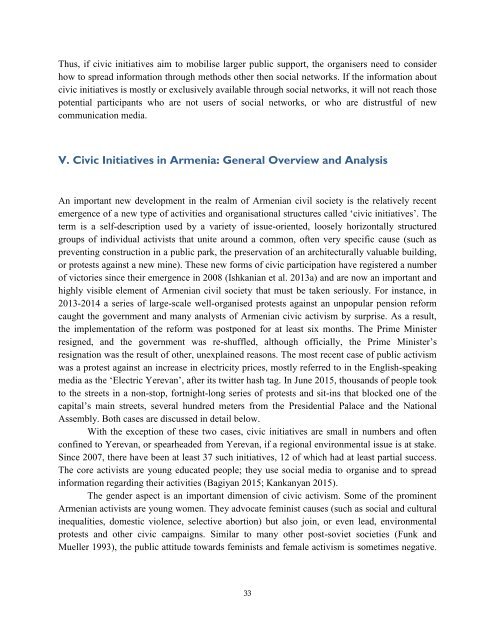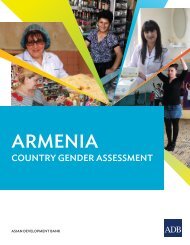Civic Activism as a Novel Component of Armenian Civil Society
English-3
English-3
You also want an ePaper? Increase the reach of your titles
YUMPU automatically turns print PDFs into web optimized ePapers that Google loves.
Thus, if civic initiatives aim to mobilise larger public support, the organisers need to consider<br />
how to spread information through methods other then social networks. If the information about<br />
civic initiatives is mostly or exclusively available through social networks, it will not reach those<br />
potential participants who are not users <strong>of</strong> social networks, or who are distrustful <strong>of</strong> new<br />
communication media.<br />
V. <strong>Civic</strong> Initiatives in Armenia: General Overview and Analysis<br />
An important new development in the realm <strong>of</strong> <strong>Armenian</strong> civil society is the relatively recent<br />
emergence <strong>of</strong> a new type <strong>of</strong> activities and organisational structures called ‘civic initiatives’. The<br />
term is a self-description used by a variety <strong>of</strong> issue-oriented, loosely horizontally structured<br />
groups <strong>of</strong> individual activists that unite around a common, <strong>of</strong>ten very specific cause (such <strong>as</strong><br />
preventing construction in a public park, the preservation <strong>of</strong> an architecturally valuable building,<br />
or protests against a new mine). These new forms <strong>of</strong> civic participation have registered a number<br />
<strong>of</strong> victories since their emergence in 2008 (Ishkanian et al. 2013a) and are now an important and<br />
highly visible element <strong>of</strong> <strong>Armenian</strong> civil society that must be taken seriously. For instance, in<br />
2013-2014 a series <strong>of</strong> large-scale well-organised protests against an unpopular pension reform<br />
caught the government and many analysts <strong>of</strong> <strong>Armenian</strong> civic activism by surprise. As a result,<br />
the implementation <strong>of</strong> the reform w<strong>as</strong> postponed for at le<strong>as</strong>t six months. The Prime Minister<br />
resigned, and the government w<strong>as</strong> re-shuffled, although <strong>of</strong>ficially, the Prime Minister’s<br />
resignation w<strong>as</strong> the result <strong>of</strong> other, unexplained re<strong>as</strong>ons. The most recent c<strong>as</strong>e <strong>of</strong> public activism<br />
w<strong>as</strong> a protest against an incre<strong>as</strong>e in electricity prices, mostly referred to in the English-speaking<br />
media <strong>as</strong> the ‘Electric Yerevan’, after its twitter h<strong>as</strong>h tag. In June 2015, thousands <strong>of</strong> people took<br />
to the streets in a non-stop, fortnight-long series <strong>of</strong> protests and sit-ins that blocked one <strong>of</strong> the<br />
capital’s main streets, several hundred meters from the Presidential Palace and the National<br />
Assembly. Both c<strong>as</strong>es are discussed in detail below.<br />
With the exception <strong>of</strong> these two c<strong>as</strong>es, civic initiatives are small in numbers and <strong>of</strong>ten<br />
confined to Yerevan, or spearheaded from Yerevan, if a regional environmental issue is at stake.<br />
Since 2007, there have been at le<strong>as</strong>t 37 such initiatives, 12 <strong>of</strong> which had at le<strong>as</strong>t partial success.<br />
The core activists are young educated people; they use social media to organise and to spread<br />
information regarding their activities (Bagiyan 2015; Kankanyan 2015).<br />
The gender <strong>as</strong>pect is an important dimension <strong>of</strong> civic activism. Some <strong>of</strong> the prominent<br />
<strong>Armenian</strong> activists are young women. They advocate feminist causes (such <strong>as</strong> social and cultural<br />
inequalities, domestic violence, selective abortion) but also join, or even lead, environmental<br />
protests and other civic campaigns. Similar to many other post-soviet societies (Funk and<br />
Mueller 1993), the public attitude towards feminists and female activism is sometimes negative.<br />
33



